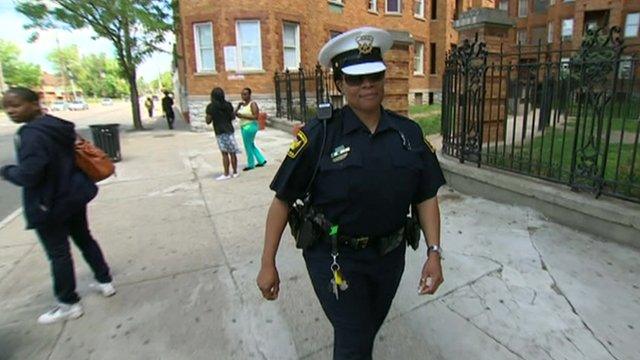Over-The-Rhine: Is this a model for urban renewal or a warning sign?
- Published

Over-the-Rhine is one of the best-known black neighborhoods in Cincinnati, Ohio
This Cincinnati neighbourhood has a storied history. Today, it's the scene of a major urban renewal effort that's prompted no small controversy.
On a typical, pre-pandemic weekend, thousands of people would descend on Cincinnati's revitalised Over-The-Rhine district just north of downtown.
Revellers would come to lounge on the grass in Washington Park, shop at any of the dozens of elegant new boutiques or meet for a beer at Rhinegeist Brewery's vast beer hall.
Over-The-Rhine, or OTR as it's better known, didn't always have a reputation as a place to kick back and relax.
Twenty years ago this April, police shot and killed Timothy Thomas, a 19-year-old unarmed black man wanted for outstanding traffic and other non-violent misdemeanours.
The anger fuelled by his death resulted in some of the worst rioting the country experienced since the Los Angeles unrest of 1992, and led to millions of dollars in property damage.
It marked an era of decline and neglect for the area, and by 2009 Over-The-Rhine ranked among America's most dangerous districts.
Since then, however, much of the district has undergone a massive and expensive regeneration process, and in many ways now finds itself almost unrecognisable from the past - for better or worse.
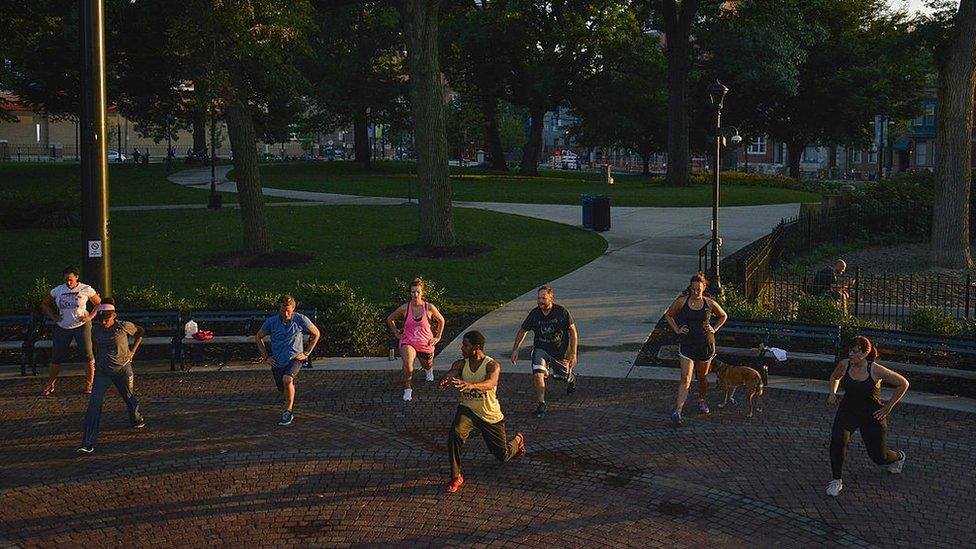
Named for the German immigrants who moved here from the mid-1800s to work in local breweries and slaughterhouses, by the early 1900s Over-The-Rhine had grown into a thriving community of tens of thousands.
A combination of anti-German sentiment sparked by the First World War, and Prohibition in the 1920s, saw many lose their jobs and leave the area.
From the 1940s, increasing numbers of migrant workers from Appalachian regions moved in, though as many saw their socio-economic circumstances improve they moved on, fleeing cramped living conditions in poorly maintained tenements.
By the 1960s, Over-The-Rhine became home for many displaced African-American residents forced from a neighbouring district by the construction of a new interstate highway.
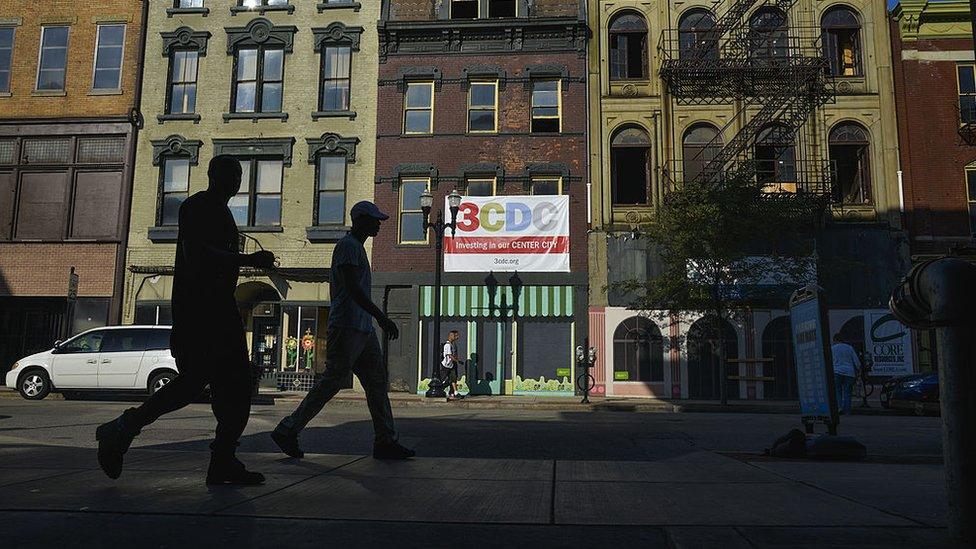
Fast forward 60 years and the area has undergone great changes. New microbreweries, throwbacks to their bustling beer-infused heritage, and quaint boutiques, restaurants and music venues have turned it into a popular going-out spot.
Its stunning collection of 19th Century German Revival and Italianate architecture ranks among the largest in the country, attracting millions of visitors every year. In 2017, the American Planning Association named Over-The-Rhine one of the nation's five "great neighbourhoods", in part as it "serves as a national model of neighbourhood revitalisation".
A streetcar ferrying revellers between Over-The-Rhine and downtown Cincinnati began operating five years ago. This spring, FC Cincinnati's sparkling new $250m (£182m), 26,000 capacity stadium is set to open outside its western fringes, providing around 1,000 new jobs.

The market is Ohio's oldest continuously operated public market and a cherished Cincinnati operation
Much of the forward progress has been the work of 3CDC, a non-profit developer established by the City of Cincinnati and local corporations such as Procter and Gamble, Fifth Third Bank and the supermarket giant, Kroger, investing around $800m in the area.
When 3CDC started out in 2004, there were almost 3,000 vacant buildings, lots and housing units in Over-The-Rhine.
Joe Rudemiller, with 3CDC, says investment specific to Over-The-Rhine has seen 173 buildings restored, another 44 new buildings constructed, and acres of "civic space" and two civic buildings refurbished.
It has also built close to a thousand condominiums and 468 apartments - 283 as affordable housing units - as well as facilities for the homeless and hundreds of thousands of square feet of commercial space.
Having spent two years selling Colombian and Venezuelan food from a pop-up tent outside Over-The-Rhine's historic Findlay Market, Isis Arrieta-Dennis jumped at the chance of opening her own eatery when the opportunity arose.
"We were looking for a place that was somehow diverse and saw that the Findlay Market was a place that would bring the diversity we needed for our business," says the Colombian native, who opened The Arepa Place nearby in 2018.
"As a woman, as a minority business owner, for me the doors have opened. The work has been hard (but) the community has given me a lot of opportunities."

Isis Arrieta-Dennis opened her storefront in 2018
Over-The-Rhine's growth has fuelled hundreds of similar businesses and a budding entrepreneurial scene that firmly positions it as one of the most dynamic urban districts in the Midwest.
But that revitalisation has also come at a cost.
It's sparked a furious debate, centred on access to affordable housing and displacement, over whether the recent changes have been positive for the existing community, or simply a prime illustration of successful gentrification.
For Maurice Wagoner, president of the Over-The-Rhine community council, a proposed $77m mixed development project at the intersection of Liberty and Elm streets (3CDC is not involved) is just the latest example of local black families being left behind and excluded.
Rents at the development are set to range from $1,400 to $2,800 - out of reach for most locals, Wagoner says - while the developers are seeking a $20m, thirty-year tax abatement.
"They're (the developers) using our tax dollars to build this development, and we can't afford to live (here). The average person can't afford to live in there," he says, pointing to the site.
A 2016 report produced for the Community Council found a 73% drop in affordable housing in Over-The-Rhine between 2002 and 2015.
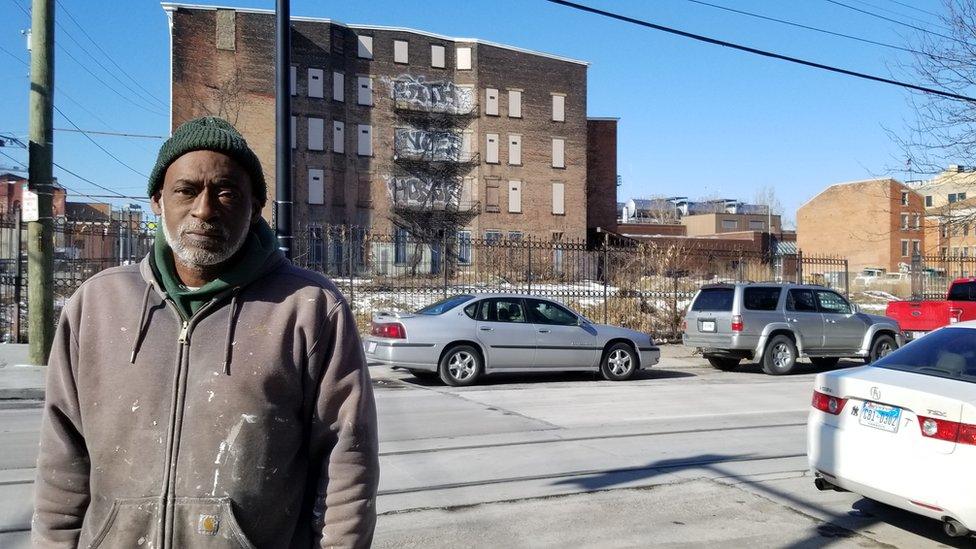
"We don't have no qualms against development," says Wagoner, who has lived in the area since 2012 but has been involved in community issues for 13 years.
"But we want equitable development. The people here, they want to improve their quality of life, they want to be part of the revitalisation. But they can't be a part of what they see going on in the neighbourhood."
Supporters have argued the project would be an overall positive for the district, including through job creation and greater urban density.
On 3 February, Cincinnati City Council voted to green light the development.
Many members of the local black community for whom Over-The-Rhine has been home for generations still suffer from chronic housing and jobs shortages.
Housing blight and all-too-frequent building collapses remain worrying factors for many.
Two years ago, a centrally located supermarket closed to be replaced by a new, bigger store - the first to open since 1969. But for residents in the northern areas, it means an additional mile round trip to collect groceries. Violent crime and shootings, though fewer than in the past, continue to plague the area.
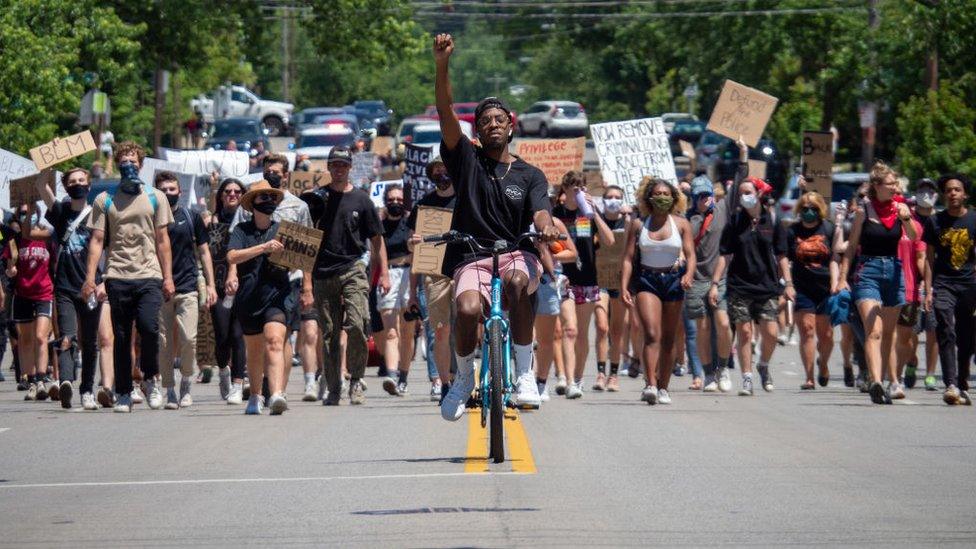
Protests over the killing of George Floyd were prominent in the district over the summer
The marginalisation black residents felt and experienced at the hands of law enforcement most infamously two decades ago still persists. Cincinnati Black Lives Matters protests were prominent in Over-The-Rhine last summer.
Job losses caused by the pandemic have further squeezed low-income residents and small businesses alike. Arrieta-Dennis says her business has suffered a 25% fall while many local stores have been forced to close altogether.
To help, 3CDC has restructured its debt in order to assist with rent reductions and relief programs for the 80 restaurants and tenants in Over-The-Rhine and in the downtown area it supports.
Still, the broader building boom and soon-to-be-opened football stadium mean community leaders fear their biggest concerns will outlast the pandemic, with short-term rentals set to further fracture the community and change Over-The-Rhine's social fabric.
"They (developers and landlords) are making profits off Airbnbs rather than giving people a place to live in our community," says Wagoner.
"The neighbour next door to me rents it out for Airbnb. I don't know who my neighbours are anymore. It's terrible."
Related topics
- Published25 September 2019

- Published11 October 2016

- Published20 May 2015
